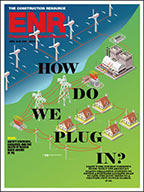At the close of its March 18 meeting, the Federal Reserve Board issued a statement that modestly adjusted monetary policy regarding future interest rate changes. Although the change was slight, it is one that could ultimately impact U.S. construction activity.
In its newest statement, the Fed removed language that said it will be “patient” about an upcoming decision to raise interest rates. Removing this language is generally believed to open the door for the Fed to raise rates sometime later this year—possibly as early as June.
Ultimately, the Fed’s timing on raising rates will heavily depend on its confidence in the continued vitality of the U.S. economy. And in the meeting minutes, the Fed lowered its forecast for economic growth and inflation and indicated it would begin to raise rates when “reasonably confident that low-inflation is on track to return to its 2% target” and as long as the job market keeps improving.
The Fed is monitoring several economic indicators to see how they play out. A number of recent economic data releases—retail sales, housing starts and industrial production, for example—suggest that the first quarter’s growth may have been weaker than previously thought.
At this point, these are more likely to be seen as temporary, weather-related phenomena—like what happened with last year’s even-steeper first quarter slowdown. But if the weakness lasts further into the year than the first quarter, a decision on interest rates could be delayed.
The Fed is also contending with the slowdown in global economic growth and how that may affect the U.S. economy. So far, the U.S. has been a safe haven in a storm of global economic turmoil. But the U.S. dollar is now rising faster than it has in years, and that increase is beginning to have an impact on trade—making U.S. goods more expensive abroad and foreign goods less expensive to U.S. consumers.
These changing conditions could have a negative impact on U.S. manufacturing and overall economic growth. On the positive side, several foreign central banks have recently made decisions to ease monetary policy, which should have a stimulative effect on global growth prospects.
The Federal Reserve’s struggle to determine how much resiliency there is in the U.S. economy is déjà vu all over again. Several times since the recession ended in mid-2009, the economy has sped up, only to slow back down to disappointing growth rates or modest declines in subsequent quarters. While this pattern of activity means the recovery has been halting, it has nevertheless marched on.
Another factor to consider is that the Fed is not likely to wait for sustained evidence of acceleration in inflation before acting. By next year, inflation is expected to be more in line with the Fed’s 2% target, given that the decline in oil prices will be in the past.
On balance, therefore, the Fed is likely to begin raising rates later this year in an effort to move monetary policy more towards neutral before that occurs.
For the construction industry, as well as the economy as a whole, the big question is how much and how quickly rate changes will occur. The Fed clearly does not want to squelch economic growth, so rate changes are probably going to be slow and steady with considerable lead time to allow the markets to adjust. That will also encourage the construction industry to adjust to changing conditions.
As long as rate increases remain muted and orderly, demand should remain largely intact and the construction market should be able to deal with the change.
Dodge Data & Analytics currently expects total construction starts to expand through 2017. At that point, higher interest rates and higher levels of inflation will begin to impede further growth. Until then, opportunity will continue to advance.
Dodge Data & Analytics, formerly McGraw Hill Construction, is the parent company of ENR Mountain States.

